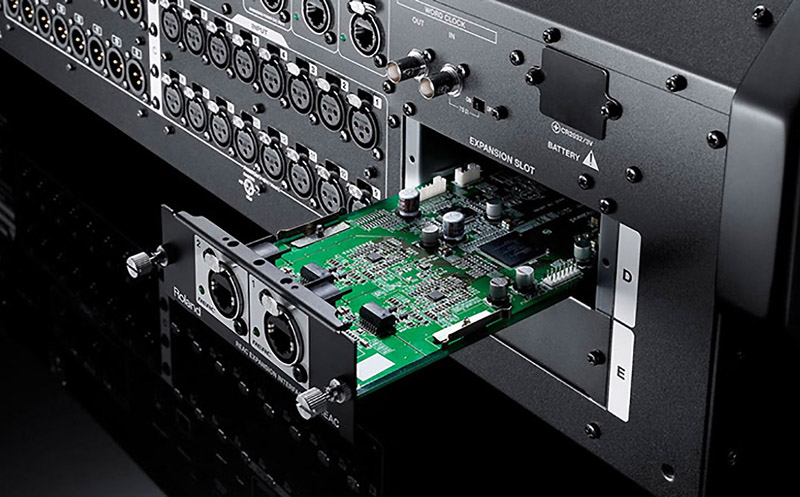
The new mc²36 is an “all-in-one” console from Lawo, offering 32 mic/line inputs, 32 line outputs, 8 digital AES3 inputs, 8 digital AES3 outputs, MADI and 3 RAVENNA network ports that can provide additional connectivity for up to 384 external inputs and outputs.
Up to three mc² compact I/O stage boxes can be connected, each with 32 mic/line inputs, 32 line outputs, 8 AES inputs, 8 AES outs, and MADI.
Also of note, the console has 21.5-inch HD touch screens and touch-sensitive color-illuminated rotary encoders, helping the operator keep track of mix functions.
The new Roland Professional A/V M-5000 console offers the company’s proprietary Open High Resolution Configurable Architecture (OHRCA), which basically means that the internal mix architecture is not fixed and can be freely defined within a range of up to 128 input/output channels/buses.
Onboard connections include 16 XLR inputs, 16 XLR outputs, 2 AES inputs, 2 AES outputs and REAC networking ports. Two option card slots allow interfacing with Dante, MADI, additional REAC streams and Waves SoundGrid.
Additional connectivity can be had via Roland digital snake boxes, including the latest, the S-2416, offering 24 XLR inputs and 16 XLR outputs.
A highly readable, well-defined 12-inch color control screen, color changing encoders, and wireless iPad control are very operator friendly.
DiGiCo has a new version of its popular compact mixer, the SD11i, which can be used as a desktop unit or rack-mounted. All 32 mix channels are now Flexi channels (configurable as stereo or mono).
The SD11i offers 16 XLR inputs, 8 XLR outputs, AES input and output, 3 USB ports, MADI and a D-Rack interface so stage boxes can be interfaced to gain additional inputs. Waves integration is also an option. In addition, DiGiCo recently released the SD app for iPad that can control all of the mix parameters for the entire SD line.
Just a couple of months ago, a second model joined the Solid State Logic Live Series, the more compact Live L300. While smaller than the original L500, it still offers 128 mix paths (96 fully processed, 32 dry) and up to 568 inputs and outputs.
Onboard there are 16 XLR inputs, 16 XLR outputs, 4 pairs of AES ports and 8 MADI ports (4 redundant pairs). Optional stage boxes can be used to increase the input count via analog, AES or MADI inputs.
SSL has a nifty network called Blacklight II, a high bandwidth multiplexed MADI approach that can be used to reduce the number of interconnecting cables. Blacklight II carries 256 (at 96 kHz) audio signals, equivalent to 8 MADI connections, bi-directionally down a single multimode fiber optic cable.
Midas recently added the 40-input M32R desktop/rack mixer to the M Series. It has 16 XLR inputs, 8 XLR bus outputs, 6 (six) 1/4-inch aux inputs and outputs (and a pair of RCA jacks also on aux 5/6), AES50 and Ultranet network ports, and USB interface port.
Additional input counts and routing can be had by adding stage boxes, including the newer DL32 (32 XLR inputs and 16 XLR outputs) and DL16 (16 XLR inputs and 8 XLR outputs).Of note is that the DL16 offers dual AES50 ports so you can cascade a pair of them with no merger or router unit required.
Mackie just came out with the DL32R rack-mount mixer that’s wirelessly controlled via iPad and iPhone. The unit has 24 XLR inputs, 8 XLR/TRS combo inputs, 14 XLR bus outputs, and a stereo AES output. There’s an option card slot, and Mackie has just announced that a Dante card is now available.
A neat feature is that USB ports are also provided for feeding audio to a computer DAW or directly into a hard drive, with the Master Fader software providing the recording and playback controls.
QSC recently entered the mixer market with the TouchMix line, comprised of two very compact models. The TouchMix-16 has 12 XLR and 4 XLR/TRS combo inputs, 2 stereo TRS inputs, 6 aux XLR outputs, 2 stereo aux TRS outputs, and main LR XLR outputs. The TouchMix-8 (now shipping, by the way) offers 4 XLR and 4 XLR combo inputs, 2 stereo inputs, 4 aux XLR outputs, 1 stereo aux TRS, and main XLR outputs.
Both models sport a color touch screen for control instead of faders, and they can also be operated wirelessly via an iPad or iPhone. A new firmware update (2.0) provides added functionality, including support for password-protected, multi-level security access, expanded Wi-Fi options (including wired connection to an infrastructure router), and programmability of user buttons.
Behringer just added a desktop-style and three compact stage box-style mixers to the X AIR digital lineup. The new X AIR X18, XR18, XR16 and XR12 incorporate an integrated Wi-Fi module and are controlled using X AIR software for both iPad and Android tablets. The XR18 has 16 XLR/TRS combo inputs and 8 XLR bus outputs, while the XR16 offers 8 XLR combo inputs, 8 (eight) 1/4-inch line inputs and 6 XLR bus outputs.
The XR12 provides 4 XLR combo connectors and 8 (eight) 1/4-inch line inputs, plus 1/4-inch aux outputs and main output XLRs. All models have a USB connector for file storage or uncompressed stereo WAV recording and playback. A future planned firmware update will add Dugan auto mixing to the feature set.
Senior contributing editor Craig Leerman is the owner of Tech Works, a production company based in Las Vegas.


